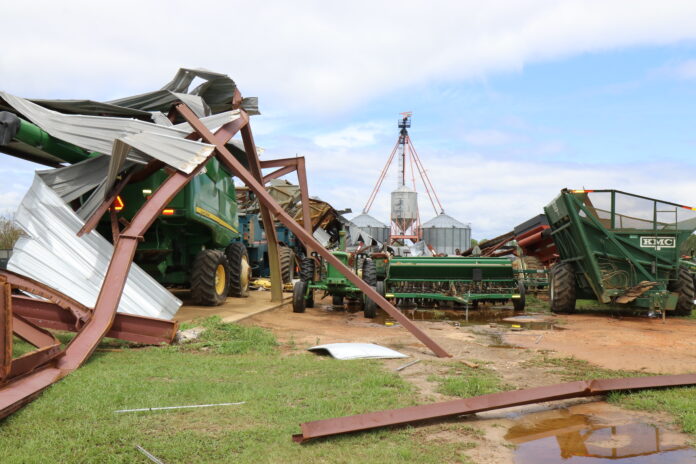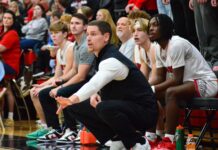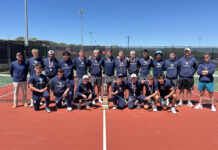MONTGOMERY, Ala. – Slow-moving Hurricane Sally stalled for hours along Alabama’s Gulf Coast Sept. 16, her creeping progress flooding fields — and farmers’ hopes for bumper harvests.
“It started blowing high winds about 3 a.m. and didn’t stop till mid-morning. It was a beating,” said Eric Street, who farms near Fairhope with his brother, Tobin. “We’ve been preparing for this our whole life. If you farm in Baldwin County, you know it’s coming.”
Before the Category 2 storm brought 100-plus mph winds and over 20 inches of rain to the Gulf Coast, Street was optimistic about his crops.
“We felt like we had a great crop of cotton, an awesome crop of peanuts and one of our best crops of soybeans,” said Street, who serves on the Alabama Farmers Federation State Soybean Committee. “I think there will be something we can harvest, but I don’t know about its quality. This is why we buy crop insurance and why we bought the new hurricane protection insurance.”
Street’s cotton crop took a beating from the hurricane, evidenced by tangled, flattened plants and cracked bolls.
“This is a huge stress on cotton,” he said. “It creates a biological stress where the bolls won’t open properly. The quality will be less because they won’t mature properly.”
Farther east in Lillian, pecans popped underfoot as Todd Cassebaum surveyed massive, overturned decades-old trees in his family’s orchard. Limbs were loaded with pecans before the storm. He predicted it would have been his best crop in years.
“Years’ worth of work is devastated,” said Cassebaum, who farms with his wife, Hope, the Baldwin County Farmers Federation president. “We had a good crop coming before the storm. The wind was so hard the trunks rocked and fell. They just couldn’t take it.”
A concrete pivot foundation ripped from the soil told a similar story at Mark Kaiser’s farm in Seminole.
“This storm just caught everyone off guard,” said Kaiser, the Federation’s District 12 director. “We knew once it slowed like that we were in trouble. There’s a certain amount of prep you can do but only so much time.”
Dillon Turk shares Kaiser’s sentiment. Across Mobile Bay in Semmes, his family’s Martin’s Nursery uncovered greenhouses in preparation for the storm.
“If a bunch of wind is coming and we know it, we need to uncover the plastic,” Turk said. “If the wind catches it, it can tear the whole greenhouse down. Since we knew something was coming, we uncovered what we could. It’s hard enough to get ready with enough heads up, much less with a day’s notice.”
Forecasters originally predicted the storm would make landfall along the Louisiana coast, but as it churned for an extended period in the Gulf, it slowly turned east, making landfall in Alabama — 16 years to the day since historic Hurricane Ivan hit the state.
For nursery growers, Turk said Sally’s heavy rain before its high winds was a blessing, as rain-soaked potted plants are harder to topple.
Fortunately, his family’s nursery got power back the day after the storm, while neighbors in Baldwin County could be without power for weeks. Snapped power poles and downed lines were common throughout much of Baldwin County.
Mobile County Farmers Federation President Art Sessions said pecan and cotton crops appear to have taken the worst hit in his county. Damage to peanuts, soybeans and nursery crops may not show up for days, he said.
Street, Cassebaum, Kaiser and Sessions said they were thankful they purchased additional hurricane crop insurance implemented by USDA’s Risk Management Agency this year.
Farmers farther inland and across south Alabama felt Sally’s wrath as well. The storm dumped record amounts of rain there, causing extensive damage to crops, pond dams and roadways.
Additional help to farmers and homeowners came in the form of extra Alfa Insurance adjusters and agents deployed to help customers impacted by Hurricane Sally.
“Alfa Insurance’s hometown adjusters and agents were checking on customers and taking claims as soon as the storm moved out,” said Alfa Insurance President Jimmy Parnell, also president of the Alabama Farmers Federation. “As of Friday morning, the company had received more than 1,600 claims across Alabama, Georgia and Mississippi. An additional 18 claims adjusters from north Alabama were being deployed to help process claims in the southern part of the state.”
Back near the Florida line in Seminole, Kaiser’s soybeans took a beating, with tiny wind-torn holes peppering the leaves. The damage will hamper pod growth, Kaiser said, reducing quality and yields.
“This was the prettiest crop of beans I’d ever seen,” Kaiser said. “We were so excited because the (soybean) market had been going up.”
In Fairhope, Street spent the day after the storm helping neighbors clear driveways. He’s waiting on fields to dry before digging peanuts next week — if a series of storms brewing in the Atlantic avoid the Gulf.
Storms like Sally put life into perspective, Street said.
“My family is accounted for, and no one is hurt. That’s what I care about,” he said. “This is going to be a kick, but we will recover.”
Farmers are encouraged to fill out a survey at AlfaFarmers.org/survey to help the Federation track damage and report findings to the U.S. Department of Agriculture. Farmers should also report damage to their local Farm Service Agency office.





















